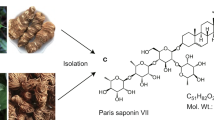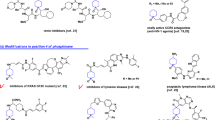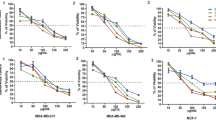Abstract
Monopolar spindle 1 (MPS1), a mitotic kinase that is overexpressed in several human cancers, contributes to the alignment of chromosomes to the metaphase plate as well as to the execution of the spindle assembly checkpoint (SAC). Here, we report the identification and functional characterization of three novel inhibitors of MPS1 of two independent structural classes, N-(4-{2-[(2-cyanophenyl)amino][1,2,4]triazolo[1,5-a]pyridin-6-yl}phenyl)-2-phenylacetamide (Mps-BAY1) (a triazolopyridine), N-cyclopropyl-4-{8-[(2-methylpropyl)amino]-6-(quinolin-5-yl)imidazo[1,2-a]pyrazin-3-yl}benzamide (Mps-BAY2a) and N-cyclopropyl-4-{8-(isobutylamino)imidazo[1,2-a]pyrazin-3-yl}benzamide (Mps-BAY2b) (two imidazopyrazines). By selectively inactivating MPS1, these small inhibitors can arrest the proliferation of cancer cells, causing their polyploidization and/or their demise. Cancer cells treated with Mps-BAY1 or Mps-BAY2a manifested multiple signs of mitotic perturbation including inefficient chromosomal congression during metaphase, unscheduled SAC inactivation and severe anaphase defects. Videomicroscopic cell fate profiling of histone 2B-green fluorescent protein-expressing cells revealed the capacity of MPS1 inhibitors to subvert the correct timing of mitosis as they induce a premature anaphase entry in the context of misaligned metaphase plates. Hence, in the presence of MPS1 inhibitors, cells either divided in a bipolar (but often asymmetric) manner or entered one or more rounds of abortive mitoses, generating gross aneuploidy and polyploidy, respectively. In both cases, cells ultimately succumbed to the mitotic catastrophe-induced activation of the mitochondrial pathway of apoptosis. Of note, low doses of MPS1 inhibitors and paclitaxel (a microtubular poison) synergized at increasing the frequency of chromosome misalignments and missegregations in the context of SAC inactivation. This resulted in massive polyploidization followed by the activation of mitotic catastrophe. A synergistic interaction between paclitaxel and MPS1 inhibitors could also be demonstrated in vivo, as the combination of these agents efficiently reduced the growth of tumor xenografts and exerted superior antineoplastic effects compared with either compound employed alone. Altogether, these results suggest that MPS1 inhibitors may exert robust anticancer activity, either as standalone therapeutic interventions or combined with microtubule-targeting chemicals.
Similar content being viewed by others
Log in or create a free account to read this content
Gain free access to this article, as well as selected content from this journal and more on nature.com
or
Abbreviations
- AURK:
-
Aurora kinase
- CDK:
-
cyclin-dependent kinase
- CIN:
-
chromosomal instability
- CYT C:
-
cytochrome c
- DiOC6(3):
-
3,3′-dihexyloxacarbocyanine iodide
- GFP:
-
green fluorescent protein
- EdU:
-
5-ethynyl-2′-deoxyuridine
- H2B:
-
histone 2B
- H3:
-
histone 3
- KT:
-
kinetochore
- MIN:
-
microsatellite instability
- Mps-BAY1:
-
N-(4-{2-[(2-cyanophenyl)amino][1,2,4]triazolo[1,5-a]pyridin-6-yl}phenyl)-2-phenylacetamide
- Mps-BAY2a:
-
N-cyclopropyl-4-{8-[(2-methylpropyl)amino]-6-(quinolin-5-yl)imidazo[1,2-a]pyrazin-3-yl}benzamide
- Mps-BAY2b:
-
N-cyclopropyl-4-{8-(isobutylamino)imidazo[1,2-a]pyrazin-3-yl}benzamide
- MPS1:
-
monopolar spindle 1
- MT:
-
microtubule
- PI:
-
propidium iodide
- SAC:
-
spindle assembly checkpoint
- siRNA:
-
small interfering RNA
- SP600125:
-
anthra[1,9-cd]pyrazole-6(2H)-one
- Z-VAD-fmk:
-
N-benzyloxycarbonyl-Val-Ala-Asp-fluoromethylketone
References
Geigl JB, Obenauf AC, Schwarzbraun T, Speicher MR . Defining ‘chromosomal instability’. Trends Genet 2008; 24: 64–69.
Gordon DJ, Resio B, Pellman D . Causes and consequences of aneuploidy in cancer. Nat Rev Genet 2012; 13: 189–203.
Hanahan D, Weinberg RA . Hallmarks of cancer: the next generation. Cell 2011; 144: 646–674.
Malumbres M . Physiological relevance of cell cycle kinases. Physiol Rev 2011; 91: 973–1007.
Liu X, Winey M . The MPS1 family of protein kinases. Annu Rev Biochem 2012; 81: 561–585.
Musacchio A, Salmon ED . The spindle-assembly checkpoint in space and time. Nat Rev Mol Cell Biol 2007; 8: 379–393.
Lan W, Cleveland DW . A chemical tool box defines mitotic and interphase roles for Mps1 kinase. J Cell Biol 2010; 190: 21–24.
Hewitt L, Tighe A, Santaguida S, White AM, Jones CD, Musacchio A et al. Sustained Mps1 activity is required in mitosis to recruit O-Mad2 to the Mad1-C-Mad2 core complex. J Cell Biol 2010; 190: 25–34.
Kwiatkowski N, Jelluma N, Filippakopoulos P, Soundararajan M, Manak MS, Kwon M et al. Small-molecule kinase inhibitors provide insight into Mps1 cell cycle function. Nat Chem Biol 2010; 6: 359–368.
Santaguida S, Tighe A, D’Alise AM, Taylor SS, Musacchio A . Dissecting the role of MPS1 in chromosome biorientation and the spindle checkpoint through the small molecule inhibitor reversine. J Cell Biol 2010; 190: 73–87.
Maciejowski J, George KA, Terret ME, Zhang C, Shokat KM, Jallepalli PV . Mps1 directs the assembly of Cdc20 inhibitory complexes during interphase and mitosis to control M phase timing and spindle checkpoint signaling. J Cell Biol 2010; 190: 89–100.
Sliedrecht T, Zhang C, Shokat KM, Kops GJ . Chemical genetic inhibition of Mps1 in stable human cell lines reveals novel aspects of Mps1 function in mitosis. PLoS One 2010; 5: e10251.
Yamagishi Y, Yang CH, Tanno Y, Watanabe Y . MPS1/Mph1 phosphorylates the kinetochore protein KNL1/Spc7 to recruit SAC components. Nat Cell Biol 2012; 14: 746–752.
London N, Ceto S, Ranish JA, Biggins S . Phosphoregulation of Spc105 by Mps1 and PP1 regulates Bub1 localization to kinetochores. Curr Biol 2012; 22: 900–906.
Colombo R, Caldarelli M, Mennecozzi M, Giorgini ML, Sola F, Cappella P et al. Targeting the mitotic checkpoint for cancer therapy with NMS-P715, an inhibitor of MPS1 kinase. Cancer Res 2010; 70: 10255–10264.
Jelluma N, Brenkman AB, van den Broek NJ, Cruijsen CW, van Osch MH, Lens SM et al. Mps1 phosphorylates Borealin to control Aurora B activity and chromosome alignment. Cell 2008; 132: 233–246.
Gregan J, Polakova S, Zhang L, Tolic-Norrelykke IM, Cimini D . Merotelic kinetochore attachment: causes and effects. Trends Cell Biol 2011; 21: 374–381.
Nezi L, Musacchio A . Sister chromatid tension and the spindle assembly checkpoint. Curr Opin Cell Biol 2009; 21: 785–795.
Ruchaud S, Carmena M, Earnshaw WC . Chromosomal passengers: conducting cell division. Nat Rev Mol Cell Biol 2007; 8: 798–812.
Liu D, Vader G, Vromans MJ, Lampson MA, Lens SM . Sensing chromosome bi-orientation by spatial separation of aurora B kinase from kinetochore substrates. Science 2009; 323: 1350–1353.
Welburn JP, Vleugel M, Liu D, Yates JR III, Lampson MA, Fukagawa T et al. Aurora B phosphorylates spatially distinct targets to differentially regulate the kinetochore-microtubule interface. Mol Cell 2010; 38: 383–392.
Hardwick KG, Weiss E, Luca FC, Winey M, Murray AW . Activation of the budding yeast spindle assembly checkpoint without mitotic spindle disruption. Science 1996; 273: 953–956.
Liang H, Lim HH, Venkitaraman A, Surana U . Cdk1 promotes kinetochore bi-orientation and regulates Cdc20 expression during recovery from spindle checkpoint arrest. EMBO J 2012; 31: 403–416.
Tighe A, Staples O, Taylor S . Mps1 kinase activity restrains anaphase during an unperturbed mitosis and targets Mad2 to kinetochores. J Cell Biol 2008; 181: 893–901.
Mattison CP, Stumpff J, Wordeman L, Winey M . Mip1 associates with both the Mps1 kinase and actin, and is required for cell cortex stability and anaphase spindle positioning. Cell Cycle 2011; 10: 783–793.
Pike AN, Fisk HA . Centriole assembly and the role of Mps1: defensible or dispensable? Cell Div 2011; 6: 9.
Yeh YH, Huang YF, Lin TY, Shieh SY . The cell cycle checkpoint kinase CHK2 mediates DNA damage-induced stabilization of TTK/hMps1. Oncogene 2009; 28: 1366–1378.
Leng M, Chan DW, Luo H, Zhu C, Qin J, Wang Y . MPS1-dependent mitotic BLM phosphorylation is important for chromosome stability. Proc Natl Acad Sci USA 2006; 103: 11485–11490.
Huang YF, Chang MD, Shieh SY . TTK/hMps1 mediates the p53-dependent postmitotic checkpoint by phosphorylating p53 at Thr18. Mol Cell Biol 2009; 29: 2935–2944.
Sancar A, Lindsey-Boltz LA, Unsal-Kacmaz K, Linn S . Molecular mechanisms of mammalian DNA repair and the DNA damage checkpoints. Annu Rev Biochem 2004; 73: 39–85.
Bartek J, Lukas J . DNA damage checkpoints: from initiation to recovery or adaptation. Curr Opin Cell Biol 2007; 19: 238–245.
Margolis RL, Lohez OD, Andreassen PR . G1 tetraploidy checkpoint and the suppression of tumorigenesis. J Cell Biochem 2003; 88: 673–683.
Vitale I, Galluzzi L, Senovilla L, Criollo A, Jemaa M, Castedo M et al. Illicit survival of cancer cells during polyploidization and depolyploidization. Cell Death Differ 2011; 18: 1403–1413.
Castedo M, Coquelle A, Vivet S, Vitale I, Kauffmann A, Dessen P et al. Apoptosis regulation in tetraploid cancer cells. EMBO J 2006; 25: 2584–2595.
Salvatore G, Nappi TC, Salerno P, Jiang Y, Garbi C, Ugolini C et al. A cell proliferation and chromosomal instability signature in anaplastic thyroid carcinoma. Cancer Res 2007; 67: 10148–10158.
Yuan B, Xu Y, Woo JH, Wang Y, Bae YK, Yoon DS et al. Increased expression of mitotic checkpoint genes in breast cancer cells with chromosomal instability. Clin Cancer Res 2006; 12: 405–410.
Daniel J, Coulter J, Woo JH, Wilsbach K, Gabrielson E . High levels of the Mps1 checkpoint protein are protective of aneuploidy in breast cancer cells. Proc Natl Acad Sci USA 2011; 108: 5384–5389.
Landi MT, Dracheva T, Rotunno M, Figueroa JD, Liu H, Dasgupta A et al. Gene expression signature of cigarette smoking and its role in lung adenocarcinoma development and survival. PLoS One 2008; 3: e1651.
Thompson SL, Compton DA . Proliferation of aneuploid human cells is limited by a p53-dependent mechanism. J Cell Biol 2010; 188: 369–381.
Manchado E, Guillamot M, Malumbres M . Killing cells by targeting mitosis. Cell Death Differ 2012; 19: 369–377.
Vitale I, Galluzzi L, Castedo M, Kroemer G . Mitotic catastrophe: a mechanism for avoiding genomic instability. Nat Rev Mol Cell Biol 2011; 12: 385–392.
Jemaa M, Galluzzi L, Kepp O, Castedo M, Rello-Varona S, Vitale I et al. Transgenerational cell fate profiling: a method for the graphical presentation of complex cell cycle alterations. Cell Cycle 2013; 12: 183–190.
Galluzzi L, Vitale I, Abrams JM, Alnemri ES, Baehrecke EH, Blagosklonny MV et al. Molecular definitions of cell death subroutines: recommendations of the Nomenclature Committee on Cell Death 2012. Cell Death Differ 2012; 19: 107–120.
Kroemer G, Galluzzi L, Vandenabeele P, Abrams J, Alnemri ES, Baehrecke EH et al. Classification of cell death: recommendations of the Nomenclature Committee on Cell Death 2009. Cell Death Differ 2009; 16: 3–11.
Kroemer G, Galluzzi L, Brenner C . Mitochondrial membrane permeabilization in cell death. Physiol Rev 2007; 87: 99–163.
Jemaa M, Vitale I, Kepp O, Berardinelli F, Galluzzi L, Senovilla L et al. Selective killing of p53-deficient cancer cells by SP600125. EMBO Mol Med 2012; 4: 500–514.
Tardif KD, Rogers A, Cassiano J, Roth BL, Cimbora DM, McKinnon R et al. Characterization of the cellular and antitumor effects of MPI-0479605, a small-molecule inhibitor of the mitotic kinase Mps1. Mol Cancer Ther 2011; 10: 2267–2275.
Fisk HA, Mattison CP, Winey M . Human Mps1 protein kinase is required for centrosome duplication and normal mitotic progression. Proc Natl Acad Sci USA 2003; 100: 14875–14880.
Steigemann P, Wurzenberger C, Schmitz MH, Held M, Guizetti J, Maar S et al. Aurora B-mediated abscission checkpoint protects against tetraploidization. Cell 2009; 136: 473–484.
Shi Q, King RW . Chromosome nondisjunction yields tetraploid rather than aneuploid cells in human cell lines. Nature 2005; 437: 1038–1042.
van der Waal MS, Hengeveld RC, van der Horst A, Lens SM . Cell division control by the chromosomal passenger complex. Exp Cell Res 2012; 318: 1407–1420.
Lacroix B, Maddox AS . Cytokinesis, ploidy and aneuploidy. J Pathol 2012; 226: 338–351.
Janssen A, Kops GJ, Medema RH . Elevating the frequency of chromosome mis-segregation as a strategy to kill tumor cells. Proc Natl Acad Sci USA 2009; 106: 19108–19113.
Markowitz SD, Bertagnolli MM . Molecular origins of cancer: molecular basis of colorectal cancer. N Engl J Med 2009; 361: 2449–2460.
Gascoigne KE, Taylor SS . Cancer cells display profound intra- and interline variation following prolonged exposure to antimitotic drugs. Cancer Cell 2008; 14: 111–122.
Galluzzi L, Aaronson SA, Abrams J, Alnemri ES, Andrews DW, Baehrecke EH et al. Guidelines for the use and interpretation of assays for monitoring cell death in higher eukaryotes. Cell Death Differ 2009; 16: 1093–1107.
Jemaa M, Galluzzi L, Kepp O, Boileve A, Lissa D, Senovilla L et al. Preferential killing of p53-deficient cancer cells by reversine. Cell Cycle 2012; 11: 2149–2158.
Vitale I, Senovilla L, Jemaa M, Michaud M, Galluzzi L, Kepp O et al. Multipolar mitosis of tetraploid cells: inhibition by p53 and dependency on Mos. EMBO J 2010; 29: 1272–1284.
Senovilla L, Vitale I, Martins I, Tailler M, Pailleret C, Michaud M et al. An immunosurveillance mechanism controls cancer cell ploidy. Science 2012; 337: 1678–1684.
Acknowledgements
We are indebted to Bert Vogelstein (Johns Hopkins University, Baltimore, MA, USA) for wild-type (WT) and TP53−/− HCT 116 cells. MJ is funded by the Ligue Nationale contre le Cancer, and LG is funded by the LabEx Immuno-Oncology. IV is funded by the Associazione Italiana per la Ricerca sul Cancro (AIRC). This work is supported by grants to GK from the Ligue Nationale contre le Cancer (Equipes Labellisée), Agence Nationale pour la Recherche (ANR), European Commission (ArtForce), European Research Council, Fondation pour la Recherche Médicale (FRM), Institut National du Cancer (INCa), Cancéropôle Ile-de-France, Fondation Bettencourt-Schueller, AXA Chair for Longevity Research, the LabEx Immuno-Oncology and the Paris Alliance of Cancer Research Institutes.
Author information
Authors and Affiliations
Corresponding authors
Ethics declarations
Competing interests
MB, UB, MK, PL, SP, VS, GS, AMW, DM and KZ are employees of Bayer Pharma AG. GK received a grant from Bayer Pharma AG. MJ, IV and GK are listed as inventors on a patent application describing the combination effects of taxanes and MPS1 inhibitors.
Additional information
Edited by G Melino
Supplementary Information accompanies this paper on the Cell Death and Differentiation website .
Supplementary information
Rights and permissions
About this article
Cite this article
Jemaà, M., Galluzzi, L., Kepp, O. et al. Characterization of novel MPS1 inhibitors with preclinical anticancer activity. Cell Death Differ 20, 1532–1545 (2013). https://doi.org/10.1038/cdd.2013.105
Received:
Revised:
Accepted:
Published:
Issue date:
DOI: https://doi.org/10.1038/cdd.2013.105
Keywords
This article is cited by
-
Monopolar spindle 1 contributes to tamoxifen resistance in breast cancer through phosphorylation of estrogen receptor α
Breast Cancer Research and Treatment (2023)
-
BID expression determines the apoptotic fate of cancer cells after abrogation of the spindle assembly checkpoint by AURKB or TTK inhibitors
Molecular Cancer (2023)
-
TTK inhibition increases cisplatin sensitivity in high-grade serous ovarian carcinoma through the mTOR/autophagy pathway
Cell Death & Disease (2021)
-
Identification of key genes and biological pathways in lung adenocarcinoma via bioinformatics analysis
Molecular and Cellular Biochemistry (2021)
-
Inhibition of mitotic kinase Mps1 promotes cell death in neuroblastoma
Scientific Reports (2020)



